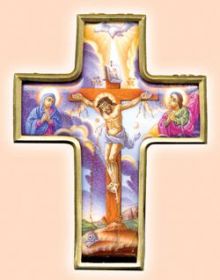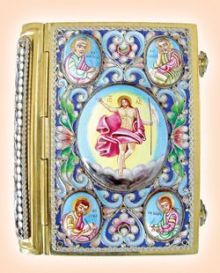Lutsk – On The Day before our Lord’s Resurrection the Volhynian Icon Museum in Lutsk, together with its friends and partners, made a special present for the residents and guests of the city. On March 23, two stories of the museum were dedicated to an exhibit of Orthodox miniatures – some of which dated from as far back as the 11th century.
The exposition was made up of items kindly donated by the Volhynian Museum of Local History, the Rivne Oblast Museum of Local History, the Musem of Books and Printing in Ostroh, and, naturally, by the Volhynian Icon Museum.
There were also some pieces from the private collections of Nifont, the Metropolitan of Lutsk and Volhyn UOC, Varfolomii, the Metropolitan of Rivne and Ostroh UOC, Hennadii Hulko, a local history expert, and other private collectors.
All together the exposition contained over 350 exhibits. These included encolpia (early Christian cruciform reliquaries – Ed.), variegated crosses – from those worn around the neck to those placed upon the Holy Table during the divine service, cast metal miniatures, icons, ancient printed books, crosses, panagias, medals, as well as souvenirs from Ukraine, Jerusalem, Greece, and Russia.
The time span and the variety of the exhibits are striking: from ancient encolpia from the 11th-century crosses to cast metal miniature icons from the 21st. A typical sample of Orthodox miniatures is the collection of Old Believers’ cast copper items from the 18th–19th centuries: three-way folding icons and crosses for the Holy Table, decorated with colored enamels.
A separate sector of the exhibit is dedicated to painted enamel miniatures. Visitors will be especially thrilled by the 19th c. icons. According to the organizers they literally fascinate you with their exquisite execution and the vivid colors. Other interesting exhibits include medallions and a crucifix for the Holy Table, and decorated with illustrations for New Testament plots – an superb example of elaborate carving on nacre.
Also, there are 30 miniature icons from the 19th-century Russian school of icon painting, including Twelve Great Feasts, Birth of Our Lady, Deity in Three Hypostases, The Burning Bush, and images of revered saints, such as St. Nicholas, John the Baptist, and others.
A further section is devoted to modern miniature religious books. There are books in Ukrainian, Russian, Greek, and Hebrew, published in Lviv, Moscow, Tel Aviv, and Athens. This is the first time that such miniature editions as John Damaskin’s Irmology (1638), Sobornyk (Collection) and Paschalion (1631), The Book of Hours (1651), and The Spiritual Alphabet (1747), have been brought to Lutsk. They were kindly donated by the Ostroh Museum of Books and Printing.
Glass souvenirs are particularly finely executed. Icon cases, vessels for blessed water and chrism, and candleholders made from china and faience, all have fascinating, variegated decorations: paintings in gold and cobalt, moldings, as well as floral and subject compositions.
The curator and employees of the Volhynian Icon Museum maintain that their present “is charged with the sublime and divine sense, conveyed via hand-made beauty and the authors’ mastery.” The Day encourages all its readers to go see this collection of masterpieces, which is permeated with both subtle aesthetic taste and holy faith in God.
Photos courtesy of the Volhynian Icon Museum, Lutsk








